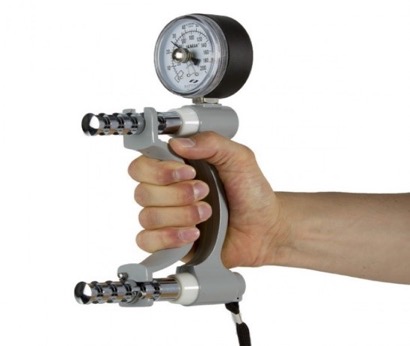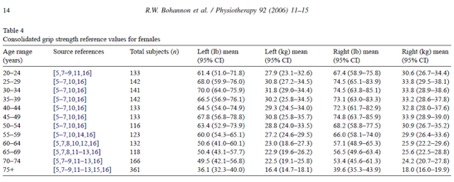How strong are we (hand-held dynamometry)?
Before making an exercise program it is necessary to test the locomotor system. Muscle strength is a component of the locomotor system that is usually tested in the fitness world. There are many tests and each has its strengths and weaknesses. However, there are no tests that directly assess the muscle strength of the entire body, or there are but we cannot apply them in recreational athletes. That is why it is necessary to have a wide variety of tests that are well researched and specific for each part of the locomotor system. The hand-held dynamometry is well researched and gives good information on the musculoskeletal state of the body.

Hand-held dynamometry
There are many different dynamometers and protocols for measuring hand grip strength. To standardize our measurement and use relevant data we must take the dynamometer and use the protocol that is most investigated. The Jamar hand-held dynamometer is commonly cited in the literature and is accepted as a gold standard compared to other dynamometers on the market.
Also, our client’s testing protocol must always be the same. One such protocol is made by the American Society of Hand Therapists respectively (ASHT) protocol. The protocol looks like this: “The subject sits in a chair leaning back with feet on the ground. The shoulder is in adduction and neutral rotation, the elbow is flexed at the angle of 90 °. The forearm is also in a neutral position, the angle in the wrist is between 0 and 30 degrees of extension and between 0 and 15 degrees of ulnar deviation. The arm or forearm should not be supported by a reclining chair or with the help of researchers. In the test, the dynamometer is positioned vertically in line with the position of the forearm and the wrist. (Roberts 2011)
Before starting the test, it should be noted that it is not necessary to warm up because heat increases the strength of the fist. Also, three attempts are adequate to achieve a maximum force without longer rest between attempts. (Innes 1999)
The table contains normative values of the grip of the fist by age and sex which enables comparing values between clients.
Figure 1. Normative values for woman

Figure 2. Normative values for men

What is the purpose of this test?
In the course of a lifetime, the grip strength in both sexes progressively increases, reaches peak around the age of 35, and progressively decreases, especially in older age. This may be related to the reduction of muscle cross-sectional area with age and various joint degenerations. (Gunther, 2008) The smaller result in the grip strength i.e. the smaller demonstrated strength in this test indicates:
- Decreased bone density (BMD) and the risk of fracture in women (Dixon 2005, Osei-Hyiaman 1998).
- Increased mortality from any cause in men = 0.81 (95% CI 0.70-0.95), (Gale 2006).
- Increased mortality rate of cardiovascular disease in males = 0.73 (95% CI 0.60 –89), (Gale 2006).
- Increased mortality rate of cancer in males = 0.81 (95% CI 0.66 –98) (Gale 2006, Ruiz 2008)
It is important to note that in men above 60 years of age the initially measured strength in this test is the predictor of diseases, however in all men younger than 60 the rate of change of grip strength is essential. Thus, if we want to properly keep track of younger people it is important to make more frequent testing to see the change in the grip strength, while in elderly strength can be measured only once to determine which risk group the person belongs to. Also, estimation of strength of the dominant and non-dominant hand can be measured and it usually goes in favor of the dominant hand about 10% (Robertson 2011).
Is this test good and how to apply it?
A test of grip strength grip measured using dynamometer is a very simple and good test to assess the muscle strength of the upper extremities, unfortunately it does not assess the strength of the whole body. As we can see above, other than the muscular strength, it indicates a very good bone mineral density. Elderly people could benefit more from such test because, as we have said, the strength of the grip of the fist increases progressively until 35 years and progressively decreases, especially in older age (60+). With this test we do not risk the injury which is very important in the elderly, as opposed to basic tests for estimation of strength and endurance that are extremely risky for such population (1 RM/maximum number of repetitions).
This test is not useful in athletes and they have more complex tests with aim of assessing the entire kinetic chain, rather than the isolated function of the upper extremities. It could be used for determining the asymmetries between left and right hand, after injury and in rehabilitation of the upper extremities due to safety of the test.
Hand-held dynamometry is a well researched test with already defined normative values that could be of use to trainers in work with recreational athletes as a part of the tool for assessing the abilities of client’s locomotor system.
- Gunther, MC. Burger, A. Rickert, M. Crispin, A. Schulz, UC. (2008). Grip strenght in healthy caucasian adults: reference values
- Osei-Hyiaman. D, Ueji, M. Toyokawa, S. Takahashi, H. Kano, K. (1999). Influence of grip strength on metacarpal bone mineral density in postmenopauzal Japanese women: A cross-sectional study
- Dixon, WG. Lunt, M. Pye, SR. Reeve, J. Felsenber, D. Silman, AJ. O׳ Neill, TW. (2005). Low grip strenght is associated with bone mineral density and vertebral fracture in women.
- Gale, RC. Matryn, NC. Cooper, C. Sayer, A. (2006). Grip strength, body composition, and mortality.
- Innes, E. (1999). Handgrip strength testing: A rewiew of the literature.
- Roberts, HC. Denison, JH. Martin, HJ. Patel, PH. Syddal, H. Cooper, C. Sayer, A. (2011). A review of the measurments of grip strength in clinical and epidemiological studies: towards a standardises approach
- JR, Sui, X. Lobelo, F. Morrow, JR. Jackson, AW. Sjostrom, M. Blair, SN. (2008). Association between muscular strength and mortality in men: prospctive cohort study.




